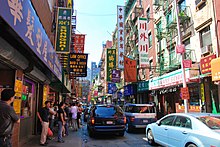There has been a Chinese influx into New York for as long as anyone can remember, but these days just as many leave as stay it seems.
Older woman with sign handing out leaflets was a far cry from a very fashionably dressed Chinese woman I saw about a block away, to say nothing of what looked like two very carefree Chinese American kids in between.
Let us see what the intenet says:
The New York metropolitan area contains the largest ethnic Chinese population outside of Asia, enumerating 659,596 individuals as of the 2008 American Community Survey Census statistical data,[63] including at least 6 Chinatowns, comprising the original Manhattan Chinatown, two in Queens (the Flushing Chinatown and the Elmhurst Chinatown), two in Brooklyn (the Sunset Park Chinatown and the Avenue U Chinatown), and one in Edison, New Jersey, not to mention fledgling ethnic Chinese enclaves emerging throughout the New York metropolitan area. Chinese Americans, as a whole, have had a (relatively) long tenure in New York City. The first Chinese immigrants came to Lower Manhattan around 1870, looking for the "gold" America had to offer.[64] By 1880, the enclave around Five Points was estimated to have from 200 to as many as 1,100 members.[64] However, the Chinese Exclusion Act, which went into effect in 1882, caused an abrupt decline in the number of Chinese who immigrated to New York and the rest of the United States.[64] Later, in 1943, the Chinese were given a small quota, and the community's population gradually increased until 1968, when the quota was lifted and the Chinese American population skyrocketed.[64]
Manhattan's Chinatown is one of the largest Chinese communities outside of Asia. Within Manhattan's expanding Chinatown lies a "Little Fuzhou" on East Broadway and surrounding streets, occupied predominantly by immigrants from the Fujian Province of Mainland China. Areas surrounding the "Little Fuzhou" consist mostly of Cantonese immigrants from Guangdong Province, the earlier Chinese settlers, and in some areas moderately of Cantonese immigrants. In the past few years, however, the Cantonese dialect that has dominated Chinatown for decades is being rapidly swept aside by Mandarin, the national language of China and the lingua franca of most of the latest Chinese immigrants.[65] The energy and population of Manhattan's Chinatown are fueled by relentless, massive immigration from Mainland China, both legal and illegal in origin, propagated in large part by New York's high density, extensive mass transit system, and huge economic marketplace.
The early settlers of Manhattan's Chinatown were mostly from Taishan and Hong Kong of the Guangdong Province of China, which are the Cantonese speakers, and also from Shanghai.[66] They form most of the Chinese population of the area surrounded by Mott and Canal Streets.[66] The later settlers, from Fuzhou, Fujian, form the Chinese population of the area bounded by East Broadway.[66] Chinatown's modern borders are roughly Delancey/Kenmare Street on the north, Broadway on the west, Chamber Street on the east, and East Broadway to the south.[67] [66]
The Flushing Chinatown, in the Flushing area of the borough of Queens in New York City, is one of the largest and fastest growing ethnic Chinese enclaves outside of Asia, as well as within New York City itself. Main Street and the area to its west, particularly along Roosevelt Avenue, have become the primary nexus of Flushing Chinatown. However, Chinatown continues to expand southeastward along Kissena Boulevard and northward beyond Northern Boulevard. In the 1970s, a Chinese community established a foothold in the neighborhood of Flushing, whose demographic constituency had been predominantly non-Hispanic white. Taiwanese began the surge of immigration, followed by other groups of Chinese. By 1990, Asians constituted 41% of the population of the core area of Flushing, with Chinese in turn representing 41% of the Asian population.[68] However, ethnic Chinese are constituting an increasingly dominant proportion of the Asian population as well as of the overall population in Flushing and its Chinatown. A 1986 estimate by the Flushing Chinese Business Association approximated 60,000 Chinese in Flushing alone.[69] Mandarin Chinese (including Northeastern Mandarin), Fuzhou dialect, Min Nan Fujianese, Wu Chinese, Beijing dialect, Wenzhounese, Shanghainese, Cantonese, Taiwanese, and English are all prevalently spoken in Flushing Chinatown. Even the relatively obscure Dongbei style of cuisine indigenous to Northeast China is now available in Flushing Chinatown.[70] Given its rapidly growing status, the Flushing Chinatown may surpass in size and population the original New York City Chinatown in the borough of Manhattan within a few years, and it is debatable whether this has already happened.




No comments:
Post a Comment
Please leave a comment-- or suggestions, particularly of topics and places you'd like to see covered